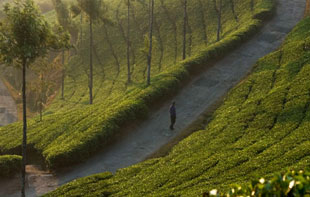Kerala.com Travel Division
WorldViewer Dot Com (India) Pvt. Ltd.
II Floor, G 66, Elders Forum Road
Panampilly Nagar, Cochin, Kerala, India
Pin - 682 036
Mobile: + 91 98460 43403
Mobile: + 91 93886 40364

 What is the real mood of monsoon in Kerala, especially when it visits the state after a long stretch of summer? Here, rain is never the same when it casts its spell over the sea, the sands, the meadows, the slopes and the mountains. The monsoon is especially wonderful at Kuttikkanam, a beautiful village in Idukki. The whole of nature gets dream-like with the touch of the rains. The leaves sway in tune with the moody rhythm of the celestial showers.
What is the real mood of monsoon in Kerala, especially when it visits the state after a long stretch of summer? Here, rain is never the same when it casts its spell over the sea, the sands, the meadows, the slopes and the mountains. The monsoon is especially wonderful at Kuttikkanam, a beautiful village in Idukki. The whole of nature gets dream-like with the touch of the rains. The leaves sway in tune with the moody rhythm of the celestial showers.
The climatic changes in Idukki district undergo a sudden variation as we go from West to East. The western parts of the district mainly comprising of midland area experiences moderate climate, whose temperature varies between 21degree C to 27 degree C. while the eastern parts located in the highland have a comparatively cold climate with temperature varying between minus 1degree C to 15 degree C in November-January and 5 degree C to 15 degree C during March-April.
Discussing about rain in the district it can be said that it receives plenty of rains from both the Southwest monsoon during June-August and the Northeast monsoon during October- November. The normal rainfall is 3265 mm. As common to other parts of the state, the Idukki district also experiences both the southwest monsoon or Edavappathy and North-East Monsoon or Thulavarsham during June-July, which is more predominant and experiences maximum rainfall and also during October -November respectively.
The annual rainfall in the district varies from 250 to 425 cms. The western region of Devicolam taluk gets more rainfall, which goes even up to 500cms. The Eastern and Northeastern regions of the district get very low rainfall normally up to 150 cms. Munnar, Devikulam Pallivasal, Vellathooval etc. are some of the well-mentioned places experiencing high rainfall.
For Accommodation - Hotels / Resorts / Homestays in Idukki
WorldViewer Dot Com (India) Pvt. Ltd.
II Floor, G 66, Elders Forum Road
Panampilly Nagar, Cochin, Kerala, India
Pin - 682 036
Mobile: + 91 98460 43403
Mobile: + 91 93886 40364

Kerala Districts : Alappuzha | Ernakulam | Idukki | Kannur | Kollam | Kottayam | Kozhikode | Kasargod | Malappuram | Pathanamthitta |Palakkad | Thiruvananthapuram | Trichur | Wayanad
Other Destinations :Nelliyampathy | Kodanad | Fortkochi | Marari | Kulamavu| Cherai | Kanyakumari | Kumbalangi| Kuttikanam | Ramakkalmedu|Vaikom |